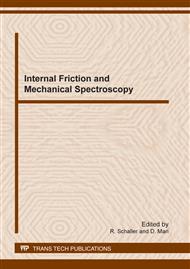[1]
A.D. Robertson, A.W. West, A.G. Ritchie, Review of crystalline lithium-ion conductors suitable for high temperature battery applications, Solid State Ionics. 104 (1997) 1-11.
DOI: 10.1016/s0167-2738(97)00429-3
Google Scholar
[2]
V. Thangadurai, H. Kaack, W.J.F. Weppner, Novel Fast Lithium Ion Conduction in Garnet-Type Li5La3M2O12 (M=Ta, Nb), J. Am. Ceram. Soc. 86 (2003) 437-440.
DOI: 10.1002/chin.200327009
Google Scholar
[3]
V. Thangadurai, W. Wepper, Li6ALa2Ta2O12(A=Ca, Sr, Ba):A new class fast lithium ion conductors with garnet-like structure, J. Am. Ceram. Soc. 88 (2005) 411-418.
DOI: 10.1111/j.1551-2916.2005.00060.x
Google Scholar
[4]
R. Murugan, W. Weppner, P.S. Beurmann, V. Thangadurai, Structure and lithium ion conductivity of garnet-like Li5La3Sb2O12 and Li6SrLa2Sb2O12, Mater. Res. Bull. 43 (2008) 2579-2591.
DOI: 10.1016/j.materresbull.2007.10.035
Google Scholar
[5]
R. Murugan, W. Wepper, P.S. Beurmann, V. Thangadurai, Structure and lithium ion conductivity of bismuth containing lithium garnets Li5La3Bi2O12 and Li6SrLa2Bi2O12, Mater. Sci. Eng. B 143 (2007) 14-20.
DOI: 10.1016/j.mseb.2007.07.009
Google Scholar
[6]
X.P. Wang, W.G. Wang, Y.X. Gao, T. Zhang, and Q.F. Fang, Low frequency internal friction study of lithium-ion conductor Li5La3Ta2O12, Mater. Sci. Eng. A 521-522 (2009) 87-89.
DOI: 10.1016/j.msea.2008.09.113
Google Scholar
[7]
W. G Wang, X.P. Wang, Y.X. Gao, J.F. Yang, and Q.F. Fang, Investigation on the stability of Li5La3Ta2O12 lithium ionic conductors in humid environment, Front. Mater. Sci. China 4 (2010) 189-192.
DOI: 10.1007/s11706-010-0017-0
Google Scholar
[8]
W.G. Wang, X.P. Wang, Y.X. Gao, and Q.F. Fang, Lithium-ionic diffusion and electrical conduction in the Li7La3Ta2O13 compounds, Solid State Ionics 180 (2009) 1252-1256.
DOI: 10.1016/j.ssi.2009.07.002
Google Scholar
[9]
Y.X. Gao, X.P. Wang, W.G. Wang, Z. Zhuang, D.M. Zhang, and Q.F. Fang, Sol-gel synthesis, ionic conductivity, and chemical compatibility of garnet-like lithium ionic conductors Li5La3Bi2O12, Solid State Ionics 181 (2010) 1415-1419.
DOI: 10.1016/j.ssi.2010.08.012
Google Scholar
[10]
K.L. Ngai, A.K. Jonscher, and C.T. White, Origin of the universal dielectric response in condense in condensed matter, Nature 277 (1979) 185-189.
DOI: 10.1038/277185a0
Google Scholar
[11]
K.L. Ngai and C.T. White, Frequency-dependence of dielectric loss in matter, Phys. Rev. B 20 (1979) 2475-2486.
DOI: 10.1103/physrevb.20.2475
Google Scholar
[12]
K.L. Ngai, R.W. Rendell, and H. Jain, Anomalous isotope-mass effect in lithium borate glasses-comparison with a unified relaxation medel, Phys. Rev. B 30 (1984) 2133-2139.
DOI: 10.1103/physrevb.30.2133
Google Scholar
[13]
K.L. Ngai and U. Strom, High-frequency dielectric loss of Na beta-alumina - evidence for relaxation crossover, Phys. Rev. B 38 (1988) 10350-10356.
DOI: 10.1103/physrevb.38.10350
Google Scholar
[14]
Y. Shi, W.B. Jiang, Q.P. Kong, P. Cui, Q.F. Fang, and M. Winning, Basic mechanism of grain-boundary internal friction revealed by a coupling model, Phys. Rev. B 73 (2006) 174101(1)-174101(6).
DOI: 10.1103/physrevb.73.174101
Google Scholar
[15]
A. K Jonscher, Physical basis of dielectric loss, Nature, 253 (1975) 717-719.
DOI: 10.1038/253717a0
Google Scholar
[16]
Q.F. Fang, X.P. Wang, G.G. Zhang, Z.J. Cheng, Evolution of internal friction and dielectric relaxation peaks in La2Mo2O9-based oxide-ion conductors assessed by a nonlinear peak-fitting method, phys. stat. sol. (a) 202 (2005) 1041-1047.
DOI: 10.1002/pssa.200420023
Google Scholar
[17]
T. Gullion and J. Schaefer, Rotational-echo double-resonance NMR, J. Magn. Reson. 81 (1989) 196-200.
DOI: 10.1016/j.jmr.2011.08.012
Google Scholar
[18]
T. Gullion, Measurement of heteronuclear dipolar interactions by rotational-echo, double-resonance nuclear magnetic resonance, Magn. Reson. Rev. 17 (1997) 83-131.
DOI: 10.1002/chin.199804295
Google Scholar


